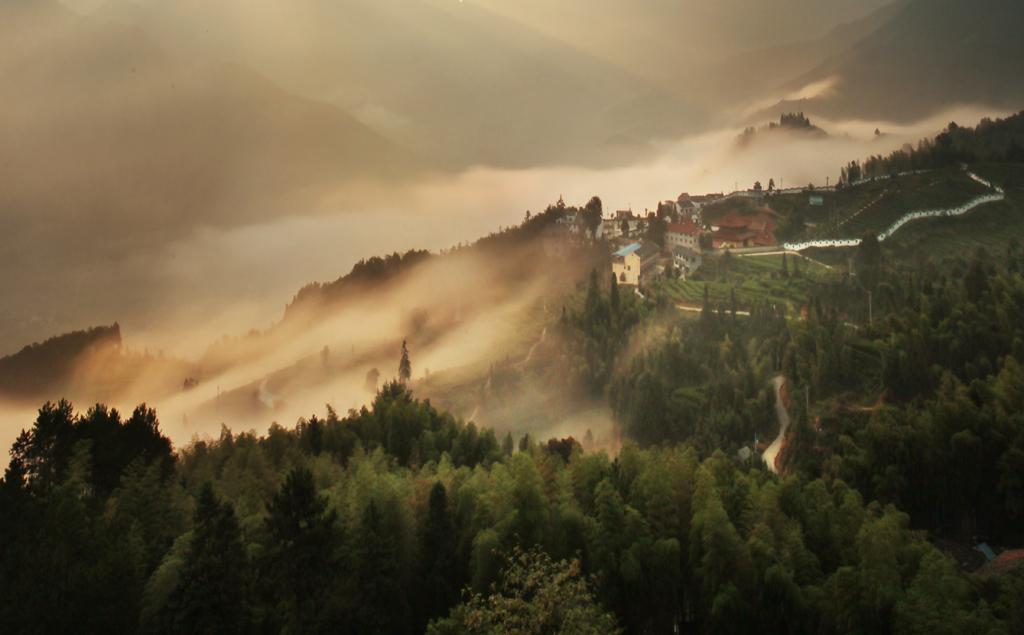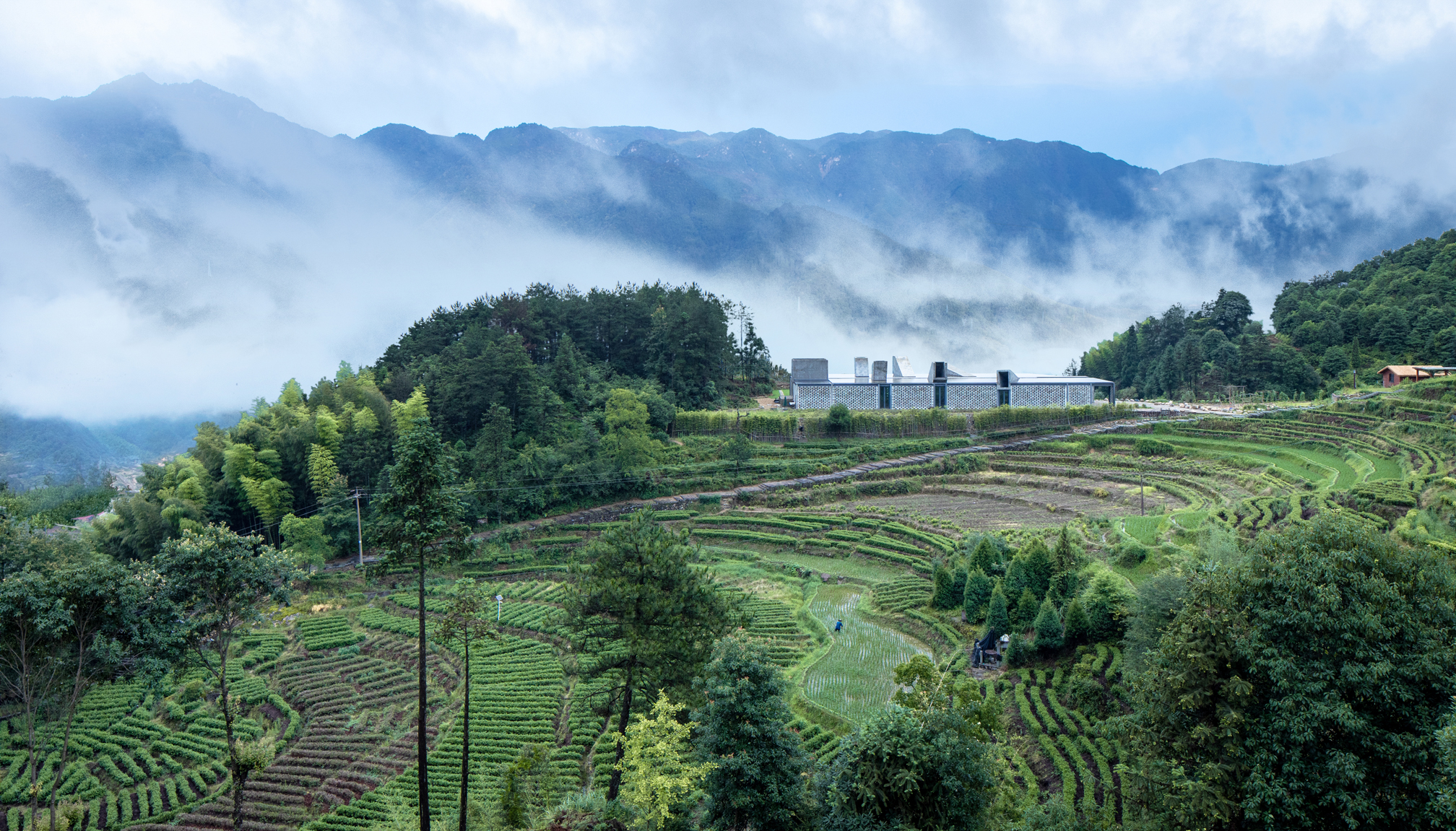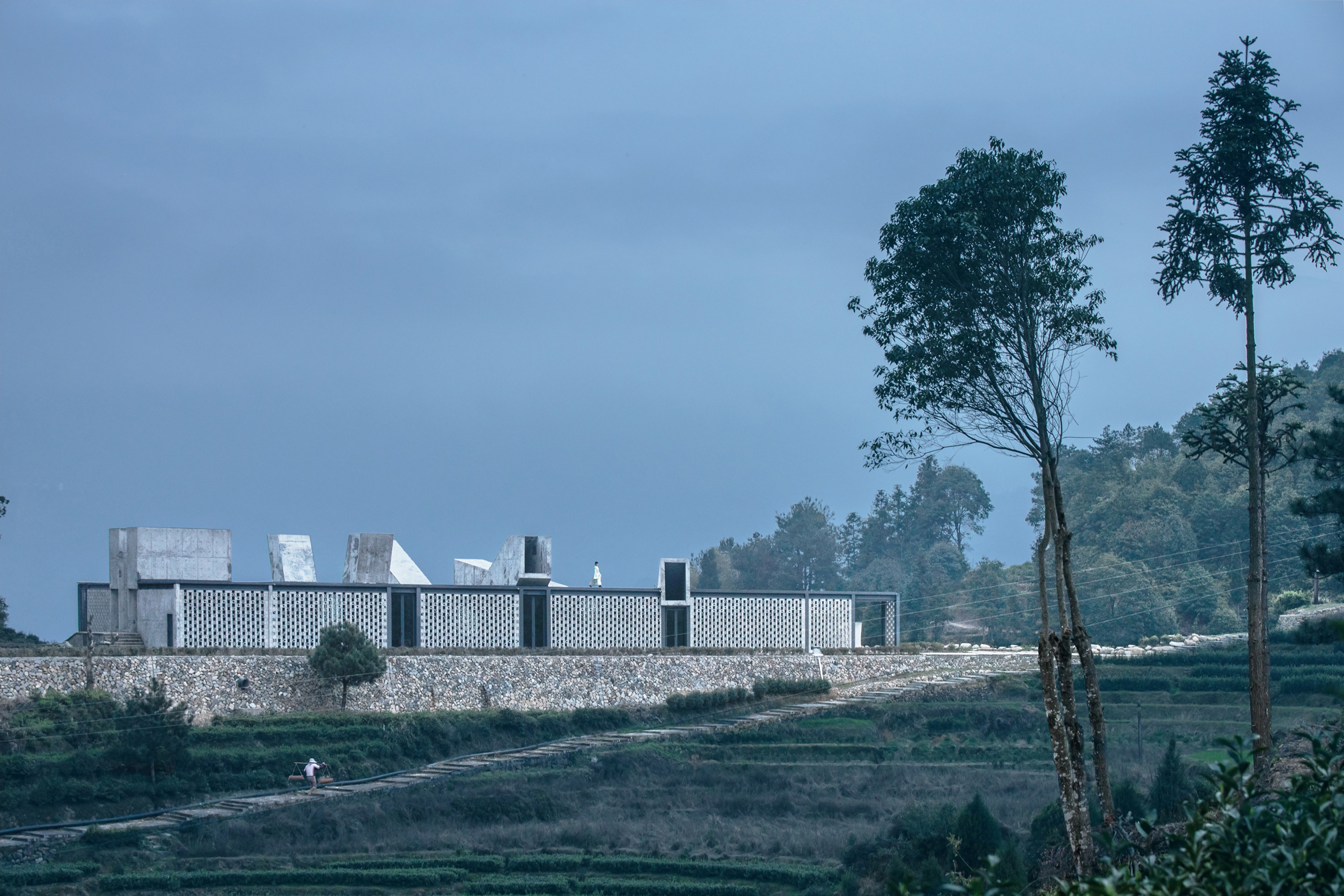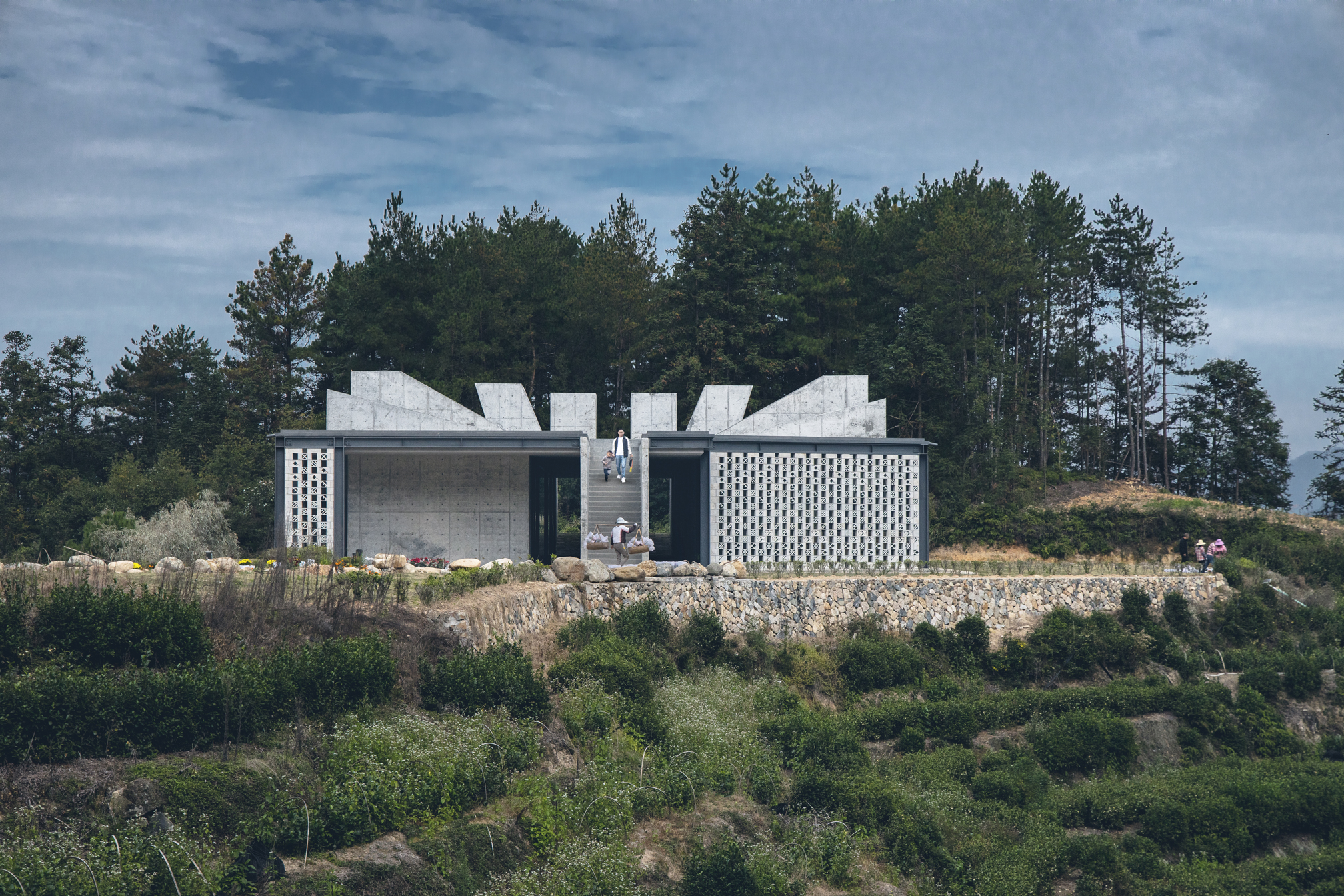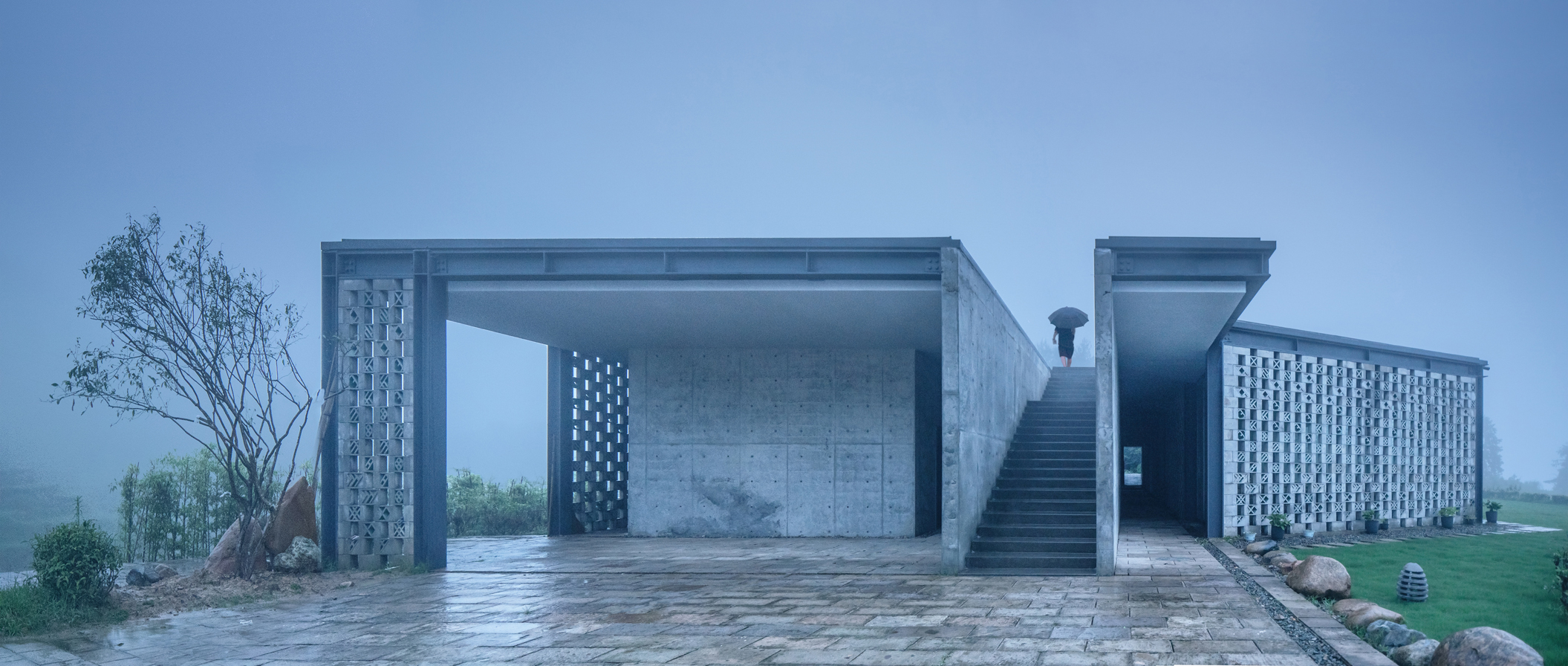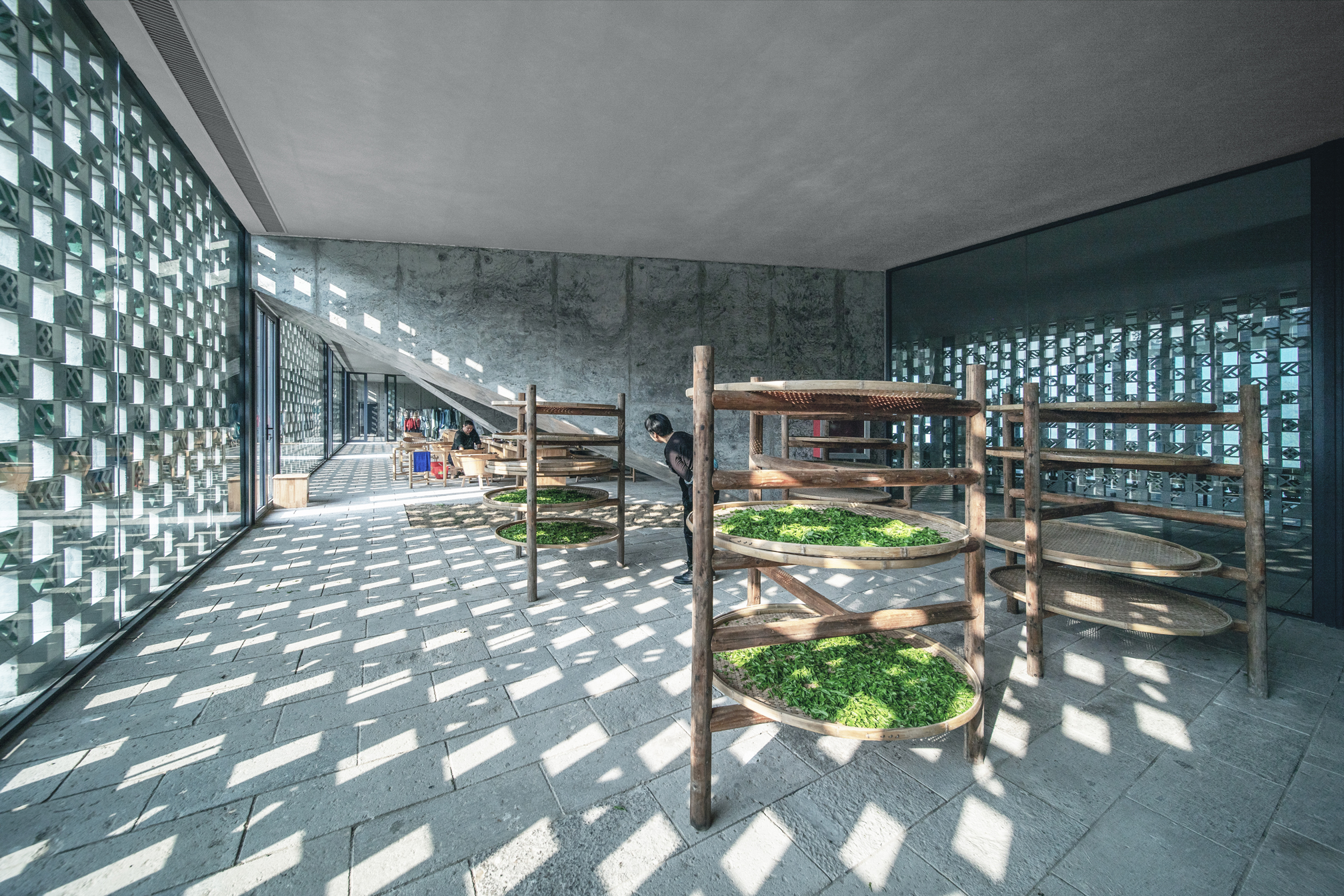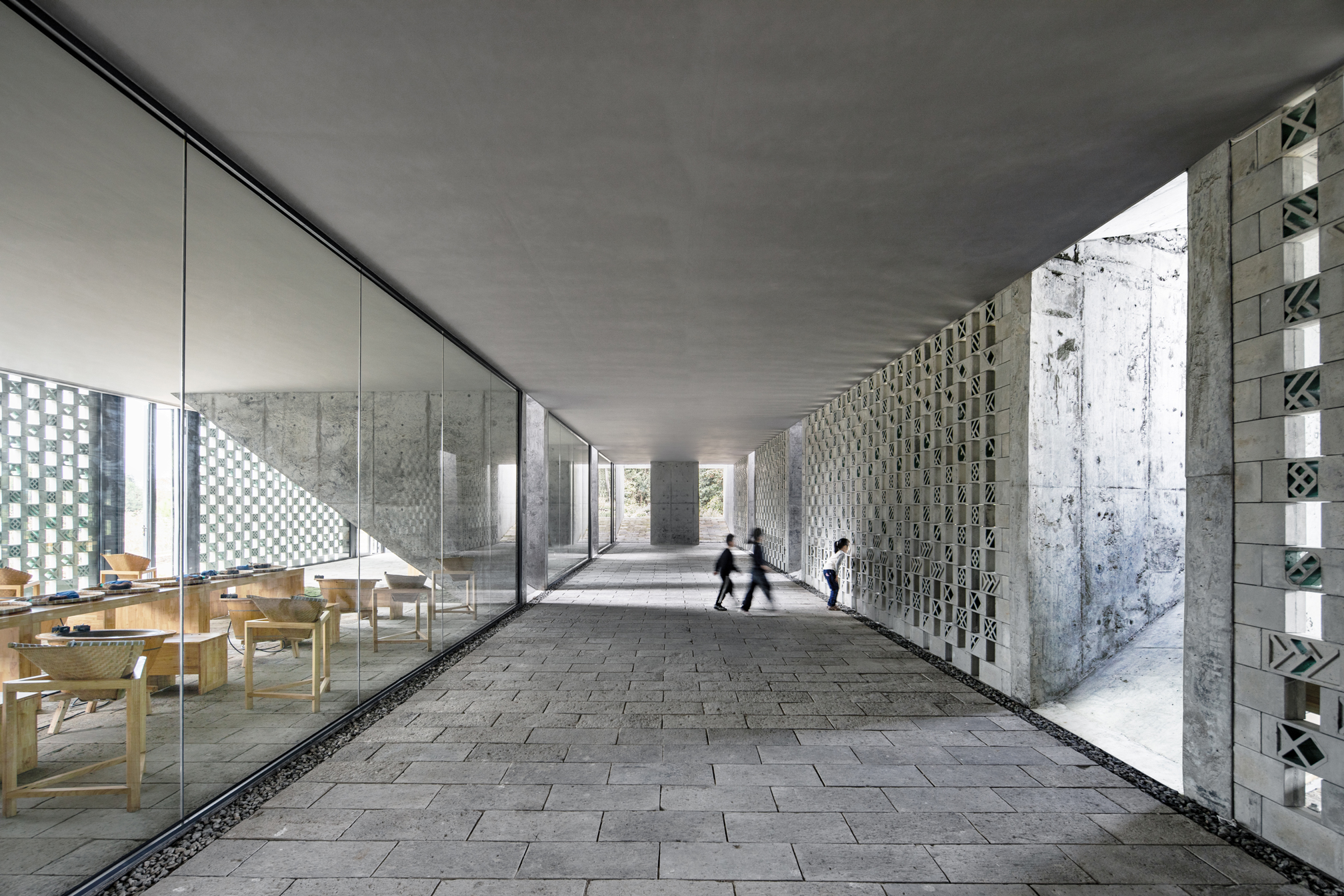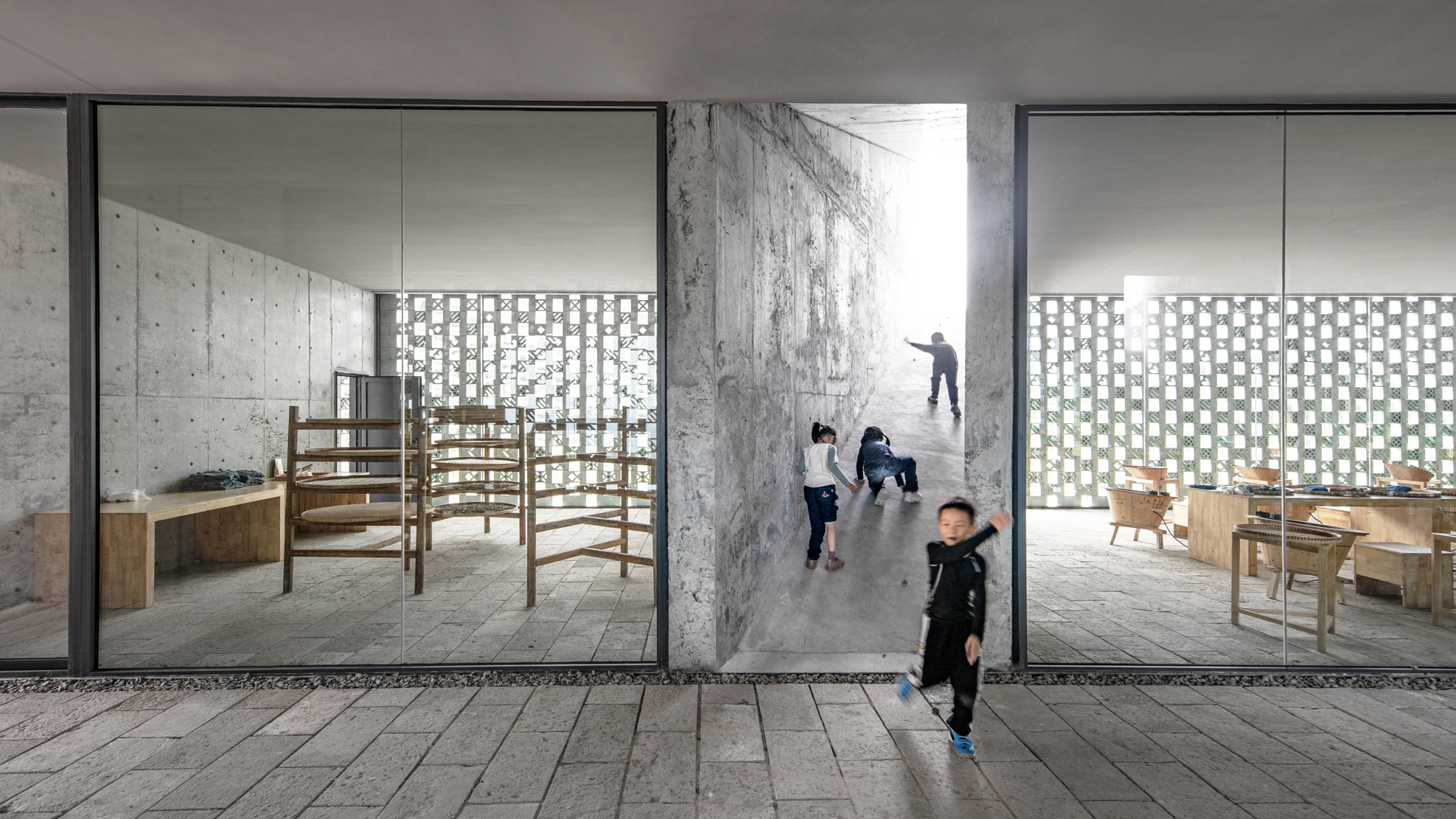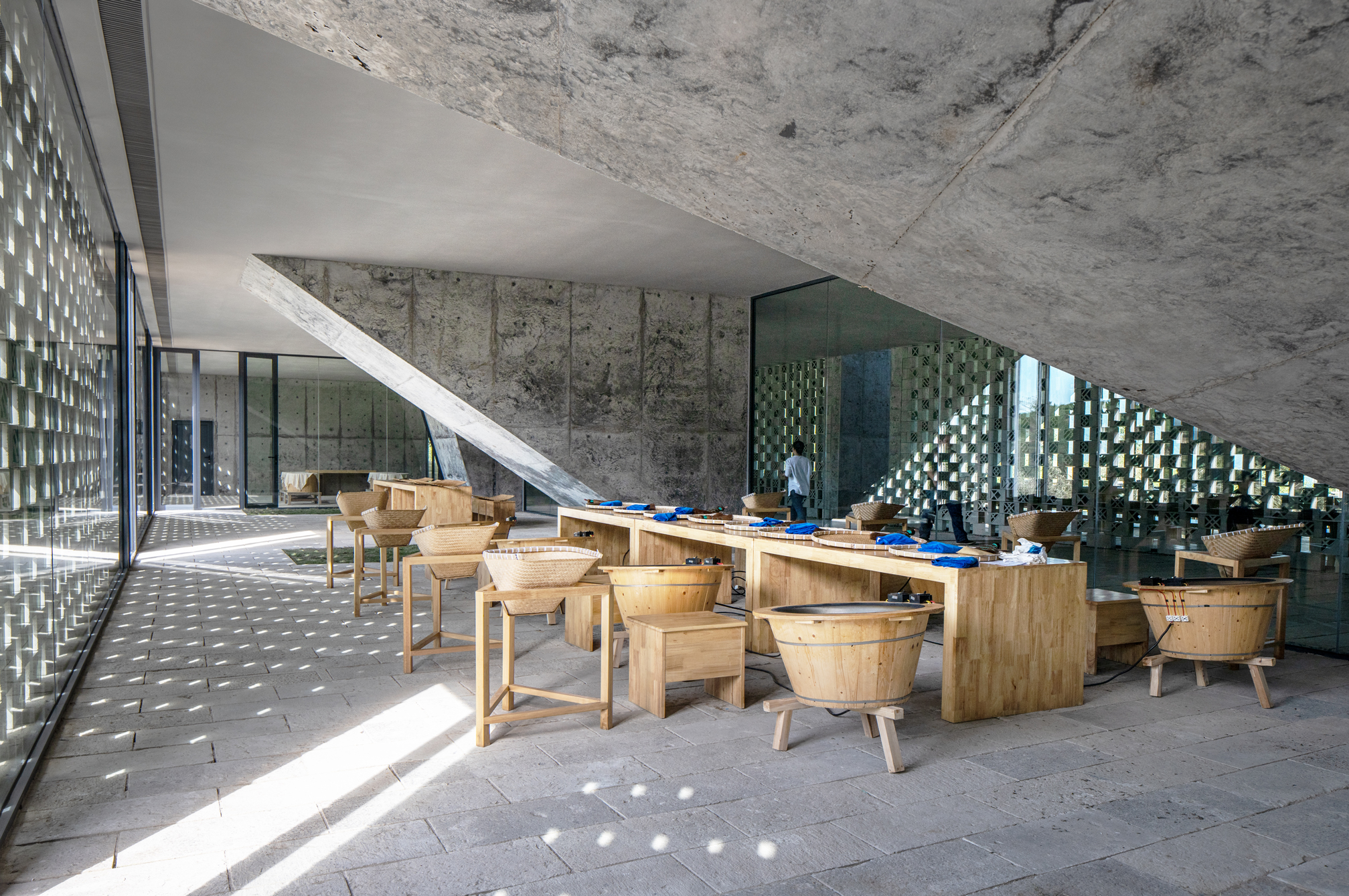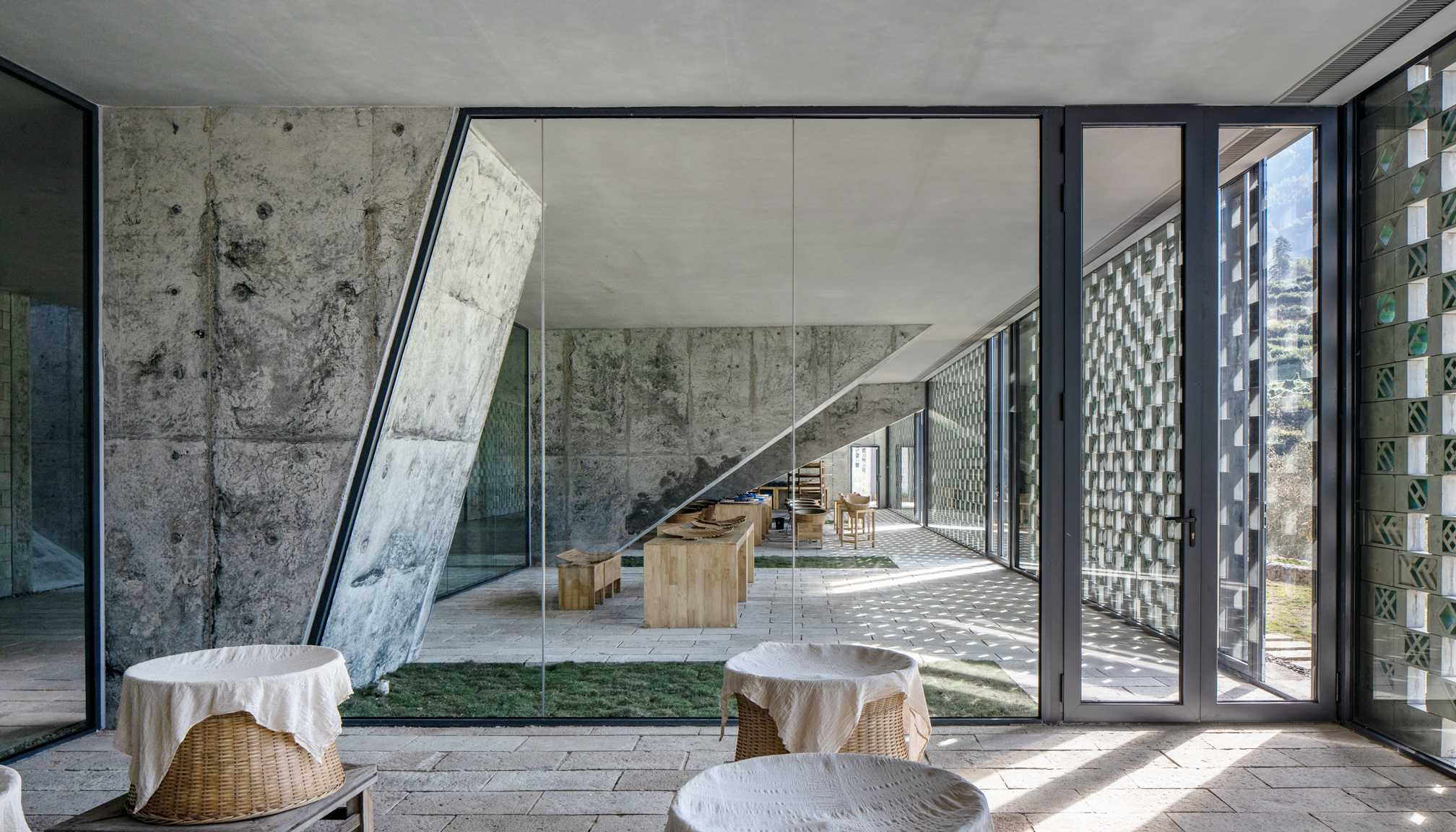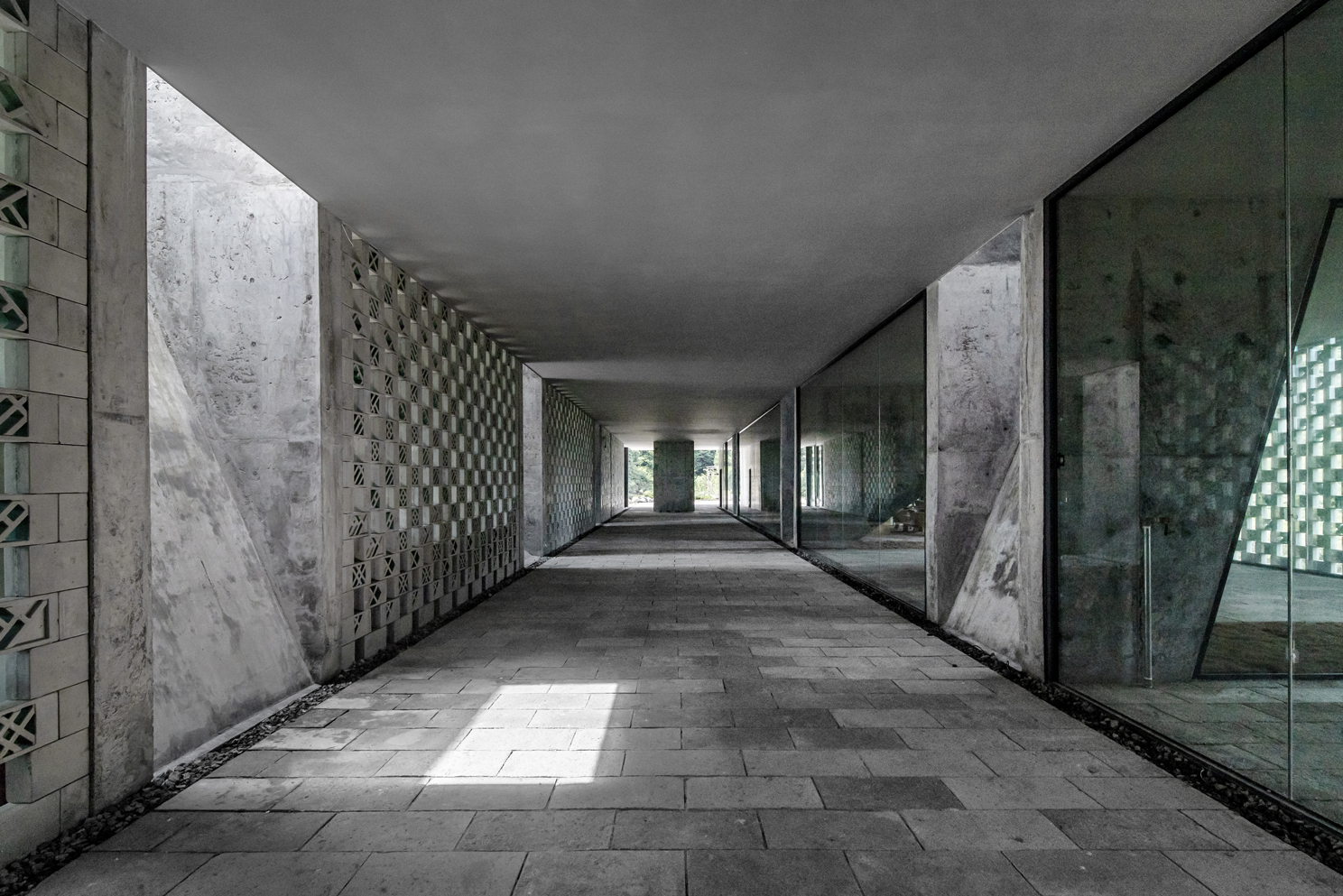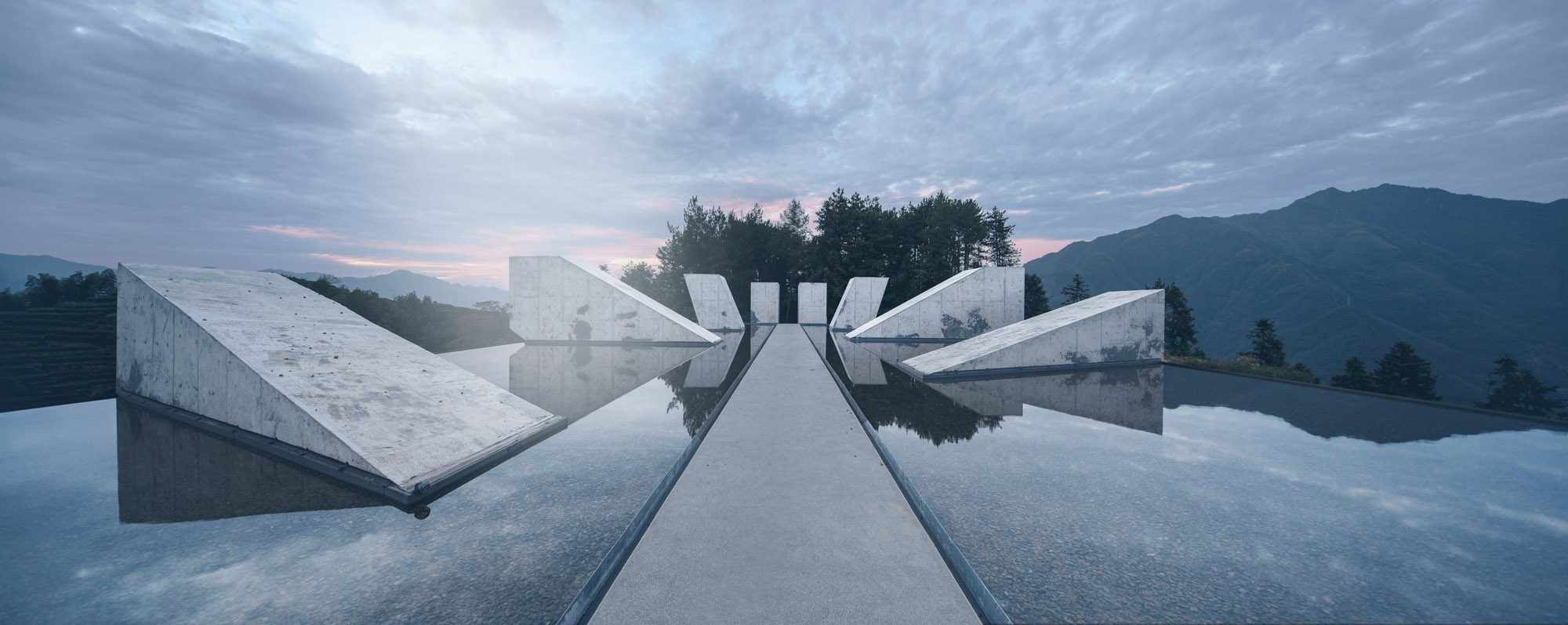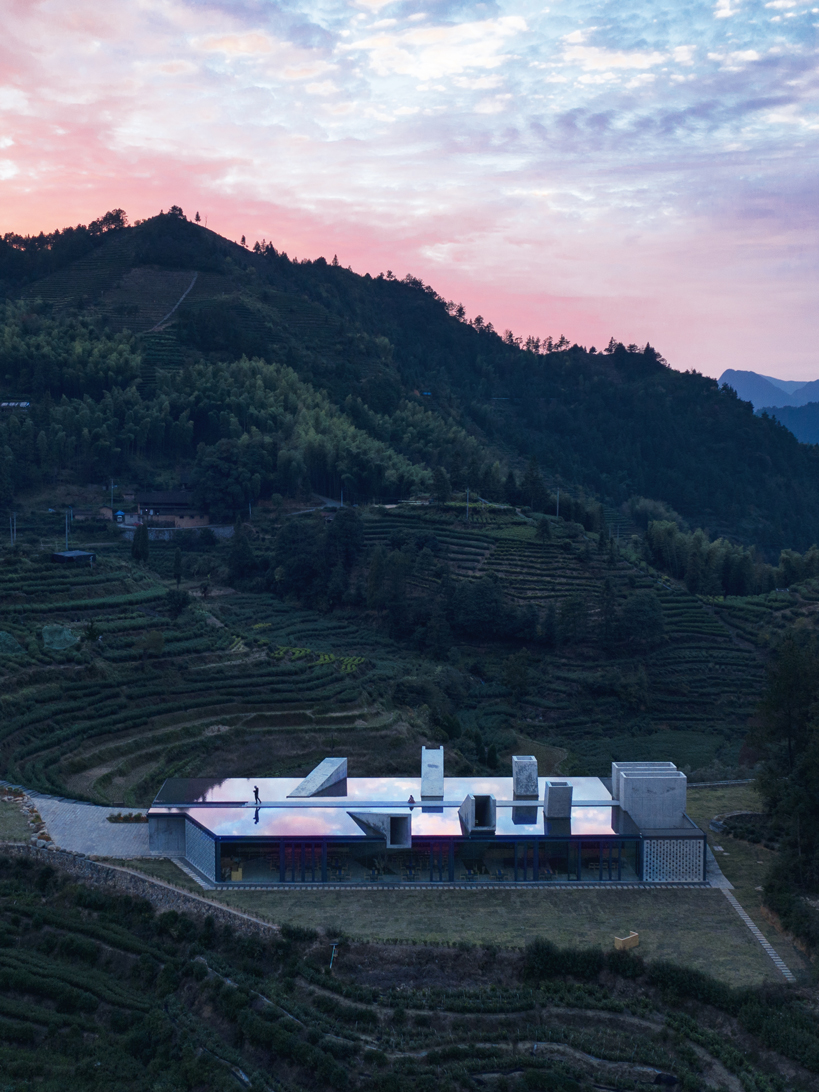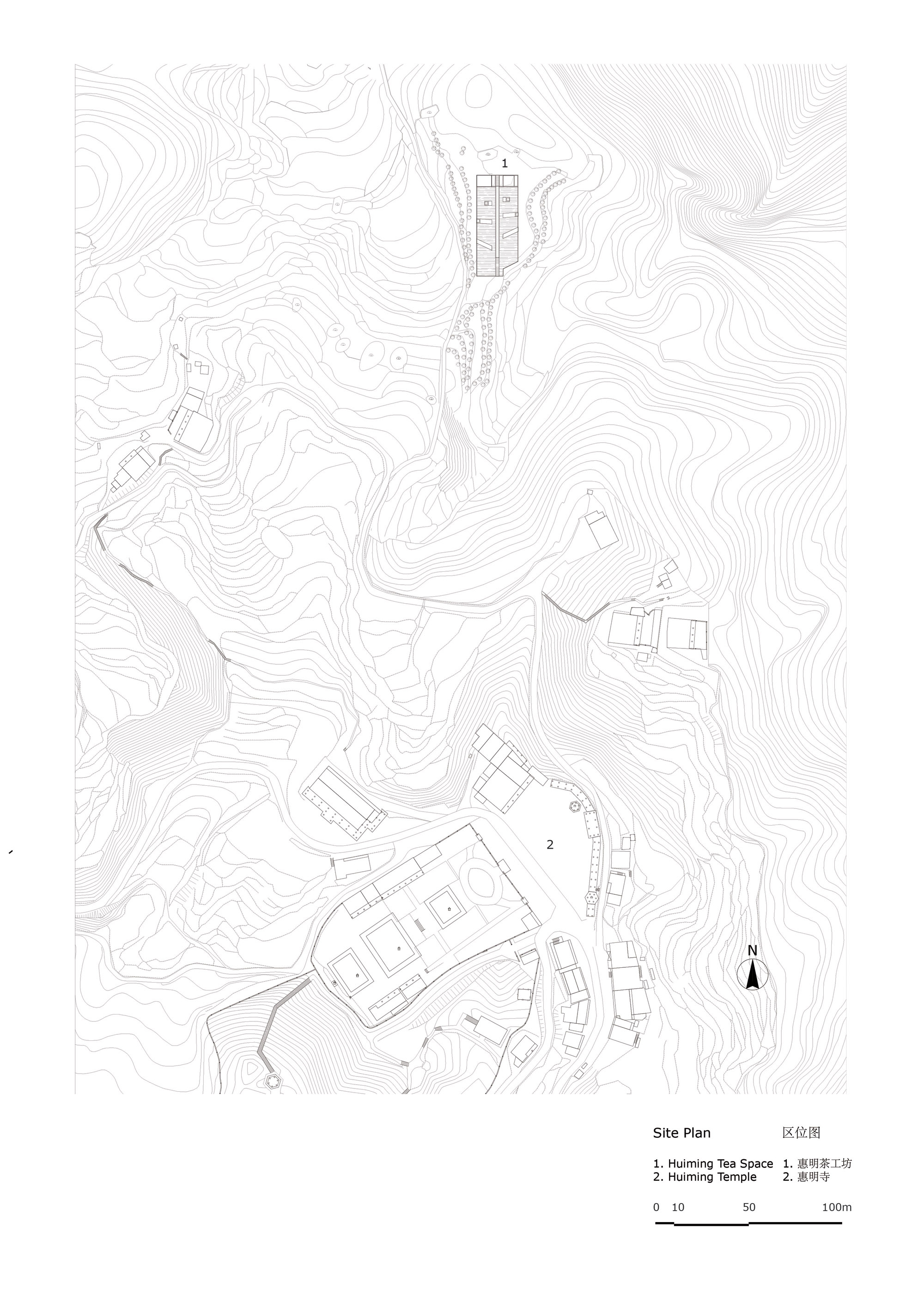景宁惠明茶工坊
Huiming Tea Space
勅木山&惠明茶
敕木山位于景宁县城外东南十里,属洞宫山脉,有敕峦霁雪、石乳洞、石井、石龛、小石碣等胜迹,常年云雾缭绕,气候湿润温和,雨量充沛,被当地畲民尊为神山。敕木山东北半山腰,冬暖夏凉,云雾蒸腾,有利于茶树的生长。唐代惠明和尚建寺于此,并和畲民在寺院周围辟地种茶。以其命名的敕木山惠明茶,已有上千年的历史和深厚的文化传承。上世纪70年代中后期,惠明寺附近的几个村落重新整合,新辟半山茶园,开启量产的茶园基地化模式,并且对惠明茶的制作流程进行了规范与整理。
惠明茶工坊
由敕木山景区管委会主导建设的惠明茶工坊,作为景区游客服务配套设施以及周边村民日常的活动场所,展示传统惠明茶制作工艺,结合地方畲族文化以及禅茶文化,未来可以作为正在扩建中的惠明寺的禅茶工坊空间。
项目选址位于惠明寺北侧的半山茶园,场地平整,呈南北走向,北面是山头的一组松树林,南面正对寺庙大门;周边大多已开垦成茶园梯田,西面地势平缓,东面则落差较大,东北方向可眺望山脚下的县城。
场地的独特地形地貌,以及周边的自然及人文环境,赋予这个项目使用功能以外更多的可能性。
建筑设计为一层的水平体量,呼应周围茶园梯田的层级,作为场地的方向标尺,由三条南北走向的平行空间构成: 面向茶园的传统惠明茶制作工坊,面向东面远山的观景品茶空间,以及中间可以观看制茶流程的休闲开放廊道。制茶和品茶构成一个完整的茶文化闭环。中间的参观廊道对外开放,是村民和游客都可以自由进出的休息场所。采茶制茶时节的传统惠明茶制作工艺流程展示和现场表演,是最直观的“劳作”展示内容。
工坊和茶室的东面墙体均采用镂空砌块墙,既能为工坊防晒遮阳,又可以分隔茶室和展廊。砌块的预制图案由畲族象形文字符号图案组成,畲族在历史上曾度过漫长的狩猎生活和“刀耕火种”的年代,有本民族语言,虽没有系统的文字,但是在长期的生产劳动中也形成了一些会意图形,可以表达简单的含意。墙面上的畲族象形文字砌块,根据符号含义沿垂直方向排列,从最下方的土地一直到上方的太阳,重构畲族山地耕猎场景,是空间的第二层文化展示内容。
纵深近五十米的参观廊道采光,除了两端的出入口,还有八个采光光筒。经过光筒到达中间廊道的光线,不仅是空间的自然照明,也通过直射光线在空间的规律展现农耕劳作及万物生长的自然本质。
夏至,日照时间最长,太阳角度最高,也是二十四节气最早被发现的节气。光筒遵循夏至当地太阳光的轨迹,追踪光线,捕捉时间。
八个光筒的角度和方位,分别根据夏至当地日出卯时到日落酉时的七个时辰的光照角度,
上午的日照时辰:卯时,辰时,巳时的三个光筒从东面茶室穿插进展廊,将茶室分割为从南侧入口公共茶室到北侧独立小茶室等四个品茶区间。
正午时分的午时则有两个并列的光筒,位于展廊北侧端头,提示路径的转换。
下午的日照时辰:未时,申时,酉时的三个光筒,从西面茶工坊穿插而入,将工坊切分为当地制茶流程的摊青,杀青,揉捻,烘干四个工艺区间。
夏至前后,每个时辰的直射光线,只能通过对应的光筒进入展廊空间。从日出到日落,经过不同形态光筒的直射光,在空间里通过光轨流转,作为刻度勾勒时间的轨迹。
日出而作日落而息,人类农耕时代的生产生活,和所有的动物植物一样,都遵循并依赖自然规律。
禅茶日晷,合生产与活动于一室,融时间与空间为一体,也是展廊的第三层内容。
八个光筒的体量和高度,是由夏至不同时辰的光线决定的。光筒突出屋面,不同的倾斜度和高度代表夏至时分当地不同时辰的太阳高度角,屋顶做浅水池夏日散热,仅保留居中的南北向直线步道,和室内的展廊形成环线,同时也强化了内外空间亮暗开合的反差。从山上俯瞰,水面反射大自然的天光云影,建筑体量消隐不见,只有一组太阳光轨的雕塑柱体,与自然对话。
Jingning County
Jingning County, part of Lishui City, Zhejiang Province, is the only She ethnic minority autonomous county in China. The She ethnic minority moved to Jingning, Zhejiang Province from Luoyuan, Fujian Province in the second year of the Tang Dynasty (766 AD). It was originally part of the Southern Chinese nomads.
Chimu Mountain & Huiming Tea
Chimu Mountain, located 10 miles southeast of Jingning County urban center. The northeast half of Chimu Mountain, warm in winter and cool in summer and steaming with clouds and fog, is favorable for tea plantations. Monk Huiming of the Tang Dynasty had built a temple here, who cleared the land around the temple with the She people to plant tea. Named after the monk, Huiming tea has had thousands of years of history and deep cultural heritage. In the mid to late 1970s, several villages near the Huiming Temple were re-integrated, together with their tea plantations to set up a standard and consolidated Huming tea production.
Huiming Tea Workshop
The Huiming Tea Workshop, led by the Chimu Mountain Scenic District Management Committee, serves as a facility for visitors to the scenic area and a place for the daily activities of the surrounding villagers, showcasing the traditional Huiming tea production process, integrating the local She culture with Buddhist culture, and is intended to become a space for Zen tea workshop for the nearby Huiming Temple in the future.
The project site is located in the mid-level tea plantation on the north side of Huiming Temple. The site is flat and runs in north-south directions. It faces a cluster of pine trees on the north hill and the temple gate to the south. Most of the surrounding area has been reclaimed for tea plantation, including leveled terrain to the west, a large drop to the east, and an overview of the county at the foot of the hill to the northeast.
The site's unique topography and the surrounding natural and human environment provide this project with more possibilities.
The building volume is designed as a one-story horizontal block, echoing the gradation of the surrounding tea plantation terraces. As indicators of the site’s direction and scale, it consists of three parallel spaces running north-south: a traditional Huiming tea-making workshop facing the tea plantation, a tea-tasting space facing the distant mountains to the east, and an open corridor in the middle as visitor lounge for observing the tea-making process. Tea making and tea tasting form a complete cycle in experiencing tea culture. The middles visitor lounge is open to the public and a place for rest for both villagers and visitors. The traditional picking and processing of Huiming tea in its harvest season best showcases and demonstrate this craft and will be the most intuitive “agricultural production exhibition” on display.
The east wall of both the workshop and the tearoom is made of perforated block walls, which can protect the workshop as sunshades and separate the tearoom from the visitor lounge. The prefabricated patterns of the blocks are composed of She pictograms. Historically, the She people has a functional oral language without a writing system. Some symbolic graphics formulated over their long-term production and labor to convey simple meanings. The She pictograph blocks on the wall are arranged vertically according to the meaning of the symbols, from the land at the bottom to the sun at the top, re-configuring the She mountain farming and hunting scene, which is the second layer of cultural display of the space.
The natural lighting for the visiting corridor, which runs for nearly fifty meters, has eight light tubes in addition to the entrance and exit at both ends. The choreography of the direct sunlight passing through these tubes indicates the basic rhythm of nature and agriculture.
In ancient China, a year is divided into the 24 Chinese solar terms as the agricultural calender to indicate the alternation of seasons and climate changes. A day is divided into 12 two-hour periods according to each zodiac animal’s activity pattern.
With the most prolonged sunlight hours and the highest solar angle, the summer solstice is also the first of the twenty-four solar terms to be discovered in Chinese history.
The angles and orientations of the eight light tubes are based on the sunlight slopes of the seven Chinese zodiac hours of the summer solstice from sunrise at dawn to sunset at dusk.
The three light tubes of the morning sunlight hours are at rabbit house 5-7am, dragon hour 7-9am, and snake hour 9-11am, intersect from the east tearoom into the visitor lounge, dividing the tea tasting space into four areas, from the public tea space to the small individual tearooms.
At horse hour 11am-1pm, the two parallel light tubes located at the northern end of the visitor lounge indicate the transition of paths.
The three light tubes of the afternoon sunlight hours: at goat hour 1-3 pm, monkey hour 3-5pm and rooster hour 5-7pm, intersect into the tea workshop in the west, dividing the workshop into four processing zones based on traditional tea production procedure.
Around the summer solstice, the direct sunlight of each zodiac hour can only enter the visitor lounge space through the corresponding light tubes. From sunrise to sunset, the natural light passing through different forms of light tubes flows into the space through the various tracks, serving as a sundial to outline the trajectory of time.
In agricultural era, the daily life circle of Chinese tradition “Working from sunrise, Resting when the sun sets”, together with the circles of all lives, animal or plants, are all based on the natural pattern of sun and light.
The space of tea is not only to integrate production and activity, but also to reveal the basic law of nature and the spirit of Zen Buddhism, implying the third layer of exhibition content.
The rooftop is covered with a thin layer of water to dissipate summer heat. A linear walkway in the middle forms a loop with the indoor visitor path leads to the Huming temple atop of the mountain. The eight tubes protrude from the roof, angled at various inclinations and heights to represent the sun's altitude at various times of the summer solstice. Looking from the hills, the water surface reflects the sky and its surrounding. The building transforms into a monumental platform with eight sunlight tubes in dialogue with nature.
